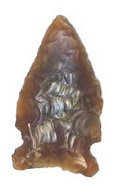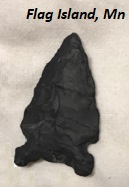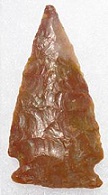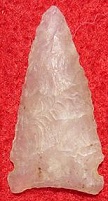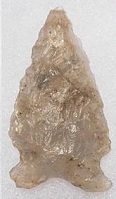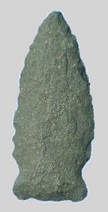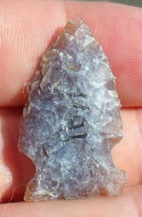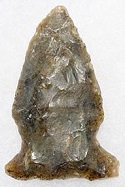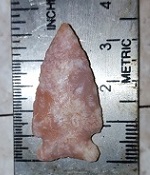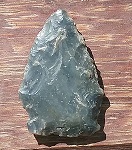Outline is Representative of Size and Shape:

Name Details:
Identified By: Boyd Wettlaufer (named) / Brian O. K. Reeves (described)
Named For: Associated culture / phase
Date Identified: 1956 / 1970
Type Site: Mortlach Site, near Moose Jaw, Saskatchewan
Identified By: Boyd Wettlaufer (named) / Brian O. K. Reeves (described)
Named For: Associated culture / phase
Date Identified: 1956 / 1970
Type Site: Mortlach Site, near Moose Jaw, Saskatchewan
Point Validity:
Valid type
Wettlaufer is a distinguished anthropologist and is considered the “Father of Saskatchewan Archeology”. This type was named in a professional publication and has many professional references. This is considered a valid type.
Wettlaufer is a distinguished anthropologist and is considered the “Father of Saskatchewan Archeology”. This type was named in a professional publication and has many professional references. This is considered a valid type.
Besant Side Notch
Cluster: Plains Large Corner Notch Cluster Description of Physical Characteristics and Flaking Pattern:
This is a broad small to medium triangular side notched point with a flattened to elliptical cross section. The blade may range from excurvate to rarely straight with the widest portion of the blade being just above the notches. Shallow parallel notches create shoulders that are most commonly angled upwards, but some examples may be almost horizontal. The stem is short and expanding and has rounded basal corners or ears. The base may vary from straight to concave with basal thinning and basal grinding present. This point is manufactured using random percussion flaking with pressure flaking used to trim and retouch the blade forming a random flaking pattern.
Size Measurements:
Total Length - 25 to 80 mm, Stem Length - 8 to 11 mm, Blade Width - 19 to 26 mm, Neck Width - 13 to 18 mm, Stem Width - 17 to 25 mm.
Total Length - 25 to 80 mm, Stem Length - 8 to 11 mm, Blade Width - 19 to 26 mm, Neck Width - 13 to 18 mm, Stem Width - 17 to 25 mm.
Commonly Utilized Material:
Various local cherts and flints with heat treatment commonly used including Avon Chert, Swan River Chert, Knife River Flint, and Quartzite
Various local cherts and flints with heat treatment commonly used including Avon Chert, Swan River Chert, Knife River Flint, and Quartzite
Additional Comments:
The oldest point in this cluster are the Pelican lake points from the Pelican Lake culture. These points overlap with the Besant points are the oldest of the Besant culture. Samantha points followed (and may have continued for a period of time) the Besant point. (W2).
Clark (1984) and Gregg and Davidson (1985) have noted the Besant phase in its eastern expression may have been strongly linked to the Hopewell culture may have been the main supplier of Knife River Flint to that exchange system.
Morrow (2016) suggest that the "Besant culture subsistence base is thought to have ranged from nomadic bison hunting on the Northwestern Plains to incipient horticulture in the southeastern end of its range, although no domesticated plant foods have been found in Besant components."
Besant points are similar to the Matanzas point, except they are shorter and wider (Morrow, 1984).
These points started as dart points along with the Besant point and were transformed into arrow points. Morrow (2016) notes the overlapping characteristics and dates of the Samantha and Besant types. He suggest that the Samantha type may be a variant of the Besant point.
The oldest point in this cluster are the Pelican lake points from the Pelican Lake culture. These points overlap with the Besant points are the oldest of the Besant culture. Samantha points followed (and may have continued for a period of time) the Besant point. (W2).
Clark (1984) and Gregg and Davidson (1985) have noted the Besant phase in its eastern expression may have been strongly linked to the Hopewell culture may have been the main supplier of Knife River Flint to that exchange system.
Morrow (2016) suggest that the "Besant culture subsistence base is thought to have ranged from nomadic bison hunting on the Northwestern Plains to incipient horticulture in the southeastern end of its range, although no domesticated plant foods have been found in Besant components."
Besant points are similar to the Matanzas point, except they are shorter and wider (Morrow, 1984).
These points started as dart points along with the Besant point and were transformed into arrow points. Morrow (2016) notes the overlapping characteristics and dates of the Samantha and Besant types. He suggest that the Samantha type may be a variant of the Besant point.
Distribution: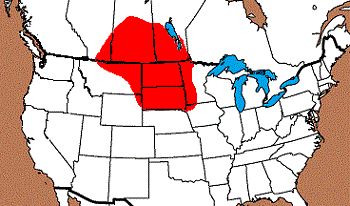
Distribution Comments:
These points are most commonly found from Alberta and Saskatchewan and into Montana, North Dakota, and Minnesota. They may be found into northern Wyoming, South Dakota, and northern Iowa with decreased frequency.
These points are most commonly found from Alberta and Saskatchewan and into Montana, North Dakota, and Minnesota. They may be found into northern Wyoming, South Dakota, and northern Iowa with decreased frequency.
Age / Periods:
Date: 1,900 - 1,300mB.P.
Cultural Period: Woodland
Glacial Period: Roman Warm to Vandal Minimum (Scandic Period)
Culture: Besant Culture
Date: 1,900 - 1,300mB.P.
Cultural Period: Woodland
Glacial Period: Roman Warm to Vandal Minimum (Scandic Period)
Culture: Besant Culture
Age Details:
The Besant culture / phase is generally dated between about 1 and 700 C.E. (Gregg and Davidson 1985:118; Forbis 1998). However, Cloutier (2004) suggests a revised age of 500 B.C.E. to 700 C.E. The Besant culture is associated with some of the earliest ceramics, including dentate stamp and punctate decoration, in central and western North Dakota (Morrow, 2016)
The Besant culture / phase is generally dated between about 1 and 700 C.E. (Gregg and Davidson 1985:118; Forbis 1998). However, Cloutier (2004) suggests a revised age of 500 B.C.E. to 700 C.E. The Besant culture is associated with some of the earliest ceramics, including dentate stamp and punctate decoration, in central and western North Dakota (Morrow, 2016)
Similar Points:
Avonlea Carmichael, Avonlea Gulf Lake, Avonlea Timber Ridge, Bratton, Little Sioux, Nanton, Sandy Creek, Simonsen, Sonota
Avonlea Carmichael, Avonlea Gulf Lake, Avonlea Timber Ridge, Bratton, Little Sioux, Nanton, Sandy Creek, Simonsen, Sonota


